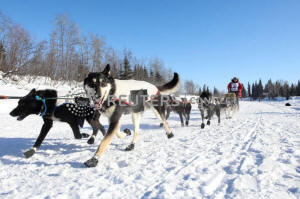|
Scaled-down Iditarod sled dog race set to
start in Anchorage
 Send a link to a friend
Send a link to a friend
 [March 01, 2019]
By Yereth Rosen [March 01, 2019]
By Yereth Rosen
ANCHORAGE, Alaska (Reuters) - When the
world's most famous sled dog race opens in downtown Anchorage on
Saturday, it will be in many ways a scaled-down event compared with past
contests.
At the starting line of the 47th Iditarod Trail Sled Dog Race will be 52
mushers and their dog teams, the fewest since 1989. The teams themselves
will be smaller, too, thanks to a new rule limiting each to 14 dogs,
down from the previous 16-dog maximum.
And the prize purse will be about $500,000, the same as last year but
still less than the $750,000 of previous years.
After a tumultuous period marked by declining sponsorship, ramped-up
animal-rights protests, bickering over management conflicts of interest
and a dog-doping scandal, Iditarod organizers and competitors say they
are adjusting.

There is a new board, new regulations and a new, if streamlined,
financial picture.
"I'm really excited about this year," Iditarod race director Mark
Nordman told reporters. "It seems like the mushers are happy."
One of the race's best-known competitors said he is also optimistic.
"It's a watershed year," said four-time champion Martin Buser, one of
five previous winners racing this year.
Buser has some misgivings about the 14-dog limit, however. The rule,
aimed at improving animal care by allowing dogs more attention from
their mushers, benefits lighter contestants over heavier rivals, he
said.
Indeed, most of this year's Iditarod mushers are small and wiry, said
Buser, who weighs about 200 pounds (91 kg).
"I'm really outnumbered," he said.
The Iditarod, commemorating the 1925 rescue mission that used a dog-team
relay to deliver life-saving diphtheria medicine to the Gold Rush town
of Nome, runs nearly 1,000 miles (1,610 km).
[to top of second column]
|

Dave Delcourt competes in the official restart of the Iditarod, a
nearly 1,000 mile (1,610 km) sled dog race across the Alaskan
wilderness, in Fairbanks, Alaska, U.S. March 6, 2017.
REUTERS/Nathaniel Wilder/File Photo

Saturday's 11-mile (18-km) starting course through Anchorage is
merely ceremonial. Timed competition begins on Sunday in the
community of Willow, about an hour's drive north.
From Willow, the trail winds through mountains and windswept flats,
then over the frozen Yukon River and along the Bering Sea coast to
the Nome finish line - a course that usually takes the winner about
nine days.
For the most part, trail conditions are good this year, with plenty
of snow through the Alaska Range and on the Yukon River, Nordman
said.
A lack of Bering Sea ice will force some inland shifts in the
approach to the finish line, lengthening the course by 30 miles to
40 miles (48 to 64 km), race officials said. But the race will go
on.
"There's nothing that's going to stop Iditarod from getting to Nome.
We've got plenty of alternatives," Nordman said.
(Reporting by Yereth Rosen in Anchorage; Editing by Steve Gorman and
Sandra Maler)
[© 2019 Thomson Reuters. All rights
reserved.]
Copyright 2019 Reuters. All rights reserved. This material may not be published,
broadcast, rewritten or redistributed.
Thompson Reuters is solely responsible for this content.
 |